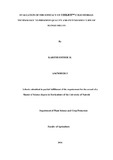| dc.description.abstract | Poor cold chain management is one of the main causes of postharvest losses (>50%) reported
in most vegetable and fruit value chains. Therefore maintenance of low temperature for
horticultural commodities is critical in postharvest handling of these perishable crops.
However, conventional cold rooms are expensive and unaffordable for majority of the
horticultural smallholder farmers. This has necessitated research in alternative low-cost
storage systems. The Coolbot™ technology is one such technology that has been used
effectively in other countries and various commodities. Transfer of the technology to Kenya
requires extensive research to validate its efficacy under local conditions. The present study
was conducted to establish efficacy of Coolbot™ technology to lower and maintain cold
temperatures during storage of mango fruits. The study also sought to evaluate the synergistic
effect of cold storage and modified atmosphere packaging (MAP) using Activebag® in
preserving quality and extending shelf life of mango fruits. The study site was Makueni
County and it was conducted over 2 seasons, between 2014 and 2015. A Coolbot™ cold
room was constructed from locally available materials including structural insulated panels
made of polystyrene to provide insulation; an LG air conditioner (24,000 BTU) and the
Coolbot™. Temperature probes were strategically positioned in the cold room and ambient
room to monitor temperature changes during the storage period. Temperature changes in the
cold room were monitored after every one hour until the preset temperature (10±1°C) was
attained. The Coolbot™ cooling efficacy studies were conducted using „Apple‟ mango
variety harvested at physiological maturity stage and stored in the cold room and ambient
room... Three fruits were sampled randomly from the two storage conditions at regular
intervals to compare progression in ripening based on changes in respiration rate, peel/flesh
color and firmness. A replicate experiment was conducted using „Apple‟ and „Ngowe‟
mango varieties. The fruits were then either packed in Active bags or left unpacked. Random sampling of three fruits was conducted after every three days to measure ripening progression
and change in quality attributes. Parameters measured include respiration rate, ethylene
evolution, cumulative weight loss, peel/flesh color and firmness, total soluble solids, total
titratable acidity, soluble sugars (fructose, glucose and sucrose), Vitamin C and ß-carotene.
Results show that Coolbot™ effectively lowered and maintained temperature at 10±1°C
throughout the storage period whereas the ambient room temperature fluctuated between 25 –
28°C. Cold-stored fruits had an extended shelf life of 35 days (compared to 12 days for fruits
in ambient room) as evidenced by slower ripening-related changes. Apple‟ mangoes in the
ambient room reached climacteric peak (53.9 ml/Kg/Hr) earlier on day 12 compared to the
delayed one observed on day 35 for cold stored fruits., the synergistic effect of cold storage
and MAP in preservation of quality and extension of shelf life of „Apple‟ and „Ngowe‟
mango varieties was demonstrated. In „Apple‟ mango, the 35 days shelf life under cold
storage was extended to 40 days under cold storage+MAP. Respiration, ethylene evolution,
color changes and softening rate were all significantly reduced under cold storage, with or
without MAP. Changes in all the fruit quality attributes including vitamin C, beta-carotene
and sugars were significantly slowed down under cold storage. Cold-stored „Apple‟ mangoes
that were packed in Active bag® retained higher Vitamin C content (59.77 mg/100ml) at the
end of storage period compared to unpacked fruits (51.8 mg/100ml).Overall, cold storage and
MAP slowed down ripening and senescence as shown in the results. The findings confirm
efficacy of the Coolbot™ technology to lower and maintain low temperatures in an insulated
storage room thereby preserving quality and extending shelf life of mango fruits. The
technology can therefore be promoted as a low-cost alternative cold storage option for
adoption by smallholder mango farmers. | en_US |



